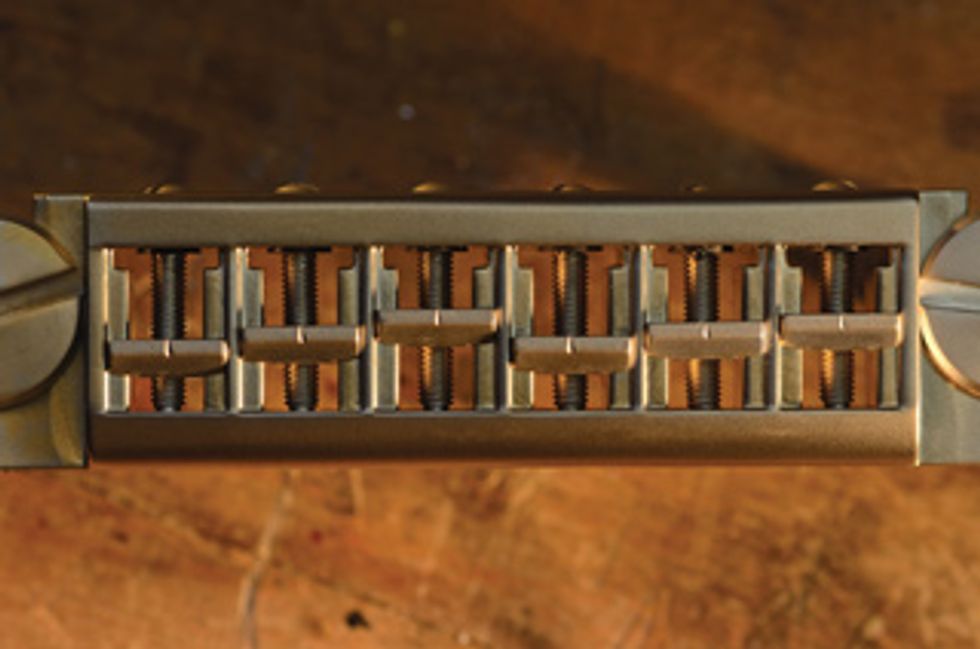
Like a freeway’s crossroad cloverleaf for commuters, a guitar’s bridge represents a crucial intersection for the transportation of tone.
Getting from one part of the sprawling Chicago metro area to another can try anyone’s patience. If your journey takes you through the fabled “Spaghetti Bowl” just west of downtown, annoyance can turn to unbridled anger. Technically known as a circle interchange, this 1950s-vintage labyrinth of ramps, curves, and crossovers merges the Dan Ryan, Eisenhower, and Kennedy Expressways with the Congress Parkway. It’s a stone’s throw from the former site of the Maxwell Street Market, where Chicago blues legends like Little Walter and Howlin’ Wolf began their careers. Sadly, Maxwell Street’s open-air flea market is gone now, but ironically, the concrete and steel monstrosity of the Bowl remains. It rates impossibly low as a way of getting to your destination quickly, unless you are Oprah on the way to the airport with a police escort. Most days traversing this path, you are consigned to trundling along ready to snap, or forced to attempt a jailbreak along the shoulder. It saps your energy no matter how Zen you try to be.
How this relates to instrument building is actually quite simple. Imagine your guitar’s tone vibrations as little commuters zipping down the strings with the intention to proceed into the wood grain and then back again. Some frequencies are in the “passing lane,” flying along determined to bounce back and forth from nut to bridge. Others move more doggedly—similar to a truck convoy—by rumbling the surface below. As vibrating strings reach the intersection of nut, bridge, tailpiece, and tuner, they are faced with a decision prescribed by physics. Even on the long return trip through neck and body, the crossroads of the neck joint looms ahead like the cash-only lane on the Tri-State Tollway.
Much like a transportation network, a guitar is a resonant system where the components all pass energy back and forth, excited further by the wallop from your amplifier. It can be a harmonious conversation that is a joy to play, or a stubborn beast that dares you to pass. Either way, there is a tonality and a temperament associated with the sum of the parts and their willingness to play nicely with each other. It would be oversimplifying things to say that the better the connection, the better the sound. It might be fair to apply this logic to sustain, but that’s quite different from tone. In fact, some players ascribe more weight to the rise of each individual note than its decay. The beginning of the note, or what I call the “nose,” is what actually stamps your sound with character. Acclaimed instrumentalist Steve Kimock refers to this as the “prefix,” and it is where the initial identity of tone resides.
Much of what makes an identifiable sound on a guitar comes from the external interface. This includes your fingers and your plectrum (if you employ one). Instead of veering off at this exit, I’ll concentrate on the geeky hardware side of things and leave the self-help stuff to another month’s column. So, I thought I’d point out what is becoming obvious at this stage: Wherever two parts join each other along the path of vibration, that spot is fair game for fine-tuning.
Perhaps you’ve heard about the brass string-nut craze of the 1970s. The brass-bridge phenomenon quickly followed, with the theory being that more mass meant more tone and sustain. The current infatuation with lightweight, aluminum tailpieces—and lightweight instruments in general—is the other side of the same, worn coin. There is a U.S. patent issued for a device that adds mass to a guitar’s headstock, and one for locking systems for bridge studs. In fact, I have a bulging file folder full of letters of introduction from inventors with “genius” patents pending. Some of the ideas might actually work, but the notion that applying all of these remedies simultaneously will result in a super-axe is a pipe dream at best. That said, judicious use of upgrades can indeed yield positive results, so let’s take a look at a few places where you can tuneup the freeway of tone.
A great place to start is to listen to the attack (the beginning of the note as described above). Is it sharp? Or is it more rounded than you’d like? If it sounds like all string and not much body, you might want to consider changing your bridge material to something that will allow the vibration to pass as opposed to reflect. Typically, a lighter material will do this.
The next place to examine is where the bridge and/or tailpiece meet the guitar’s body, which logically enough, is next in line. Are the screws, posts, or anchors tightly machined, or do they fit loosely? The physical connection between parts can either be transparent to vibration or dissipate energy before it goes further. If your goal is to engage the guitar’s wooden components (neck and body), you need to tighten up the threaded parts in the pathway and make sure the mountings fit snugly against the body. When possible, you can even use a locknut between the post and body. Bridges or tailpieces that are attached with wood screws can benefit from tightening as well.
Another place where energy can be either transferred or siphoned off is at the tuning machine. The fit of the part within the hole through the headstock is crucial to this. Be certain that the retaining nuts (if used) are fully tightened. If small screws are used to seat the machine to the headstock, make sure that they are firmly tightened as well. With softer woods like mahogany or cedar, it’s not unusual for these small screws to strip during assembly at the factory, so check to see if they need re-drilling and doweling for a better fit.
As you can see, every part-to-part mating is a potential fine-tuning point. The great thing is that if you don’t like the results, they are easily returned to where you started, or even reversed for a different effect. Unlike being stuck in rush-hour traffic in Chicago, there is an upside to every turn of the screw.
 Jol Dantzig is a
noted designer, builder,
and player who co-founded
Hamer Guitars,
one of the first boutique
guitar brands, in 1973.
Today, as the director of
Dantzig Guitar Design, he continues to
help define the art of custom guitar. To
learn more, visit guitardesigner.com.
Jol Dantzig is a
noted designer, builder,
and player who co-founded
Hamer Guitars,
one of the first boutique
guitar brands, in 1973.
Today, as the director of
Dantzig Guitar Design, he continues to
help define the art of custom guitar. To
learn more, visit guitardesigner.com.

























